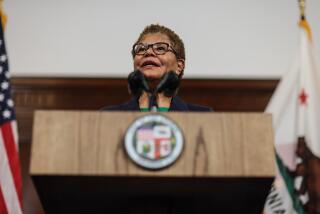A Look at Mayoral Digs in Early Egypt
- Share via
As recently as 10 years ago, some archeologists referred to ancient Egypt as the “civilization without cities.” Massive pyramids and magnificent temples dotted the barren countryside, but there were few traces of the people who built the pyramids or worshiped in the temples.
But that situation is changing rapidly, leading to a much greater understanding of the everyday lives of nonroyal Egyptians. Excavations on the Giza Plateau during the last decade, for example, have unearthed the cities of the pyramid builders--the tombs of the craftsmen and artisans, the barracks of the everyday workers and the bakeries and breweries that supported the effort.
Now, archeologist Joseph Wegner and his colleagues at the University of Pennsylvania Museum have unearthed the official residence of an Egyptian city’s mayor, the 3,700-year-old equivalent of New York City’s Gracie Mansion or Los Angeles’ Getty House.
Egyptologists have seen drawings in tombs and read text about such residences, said Zahi Hawass, Egypt’s undersecretary of state for the Giza monuments, “but this is the first one we’ve seen.”
“This is a very significant finding,” added archeologist Mark Lehner of the Harvard Semitic Museum. “It’s really good stuff for reconstructing social history.”
The new find is in the area of Abydos, where researchers from the University of Pennsylvania and Yale University have been excavating for three decades. Located on the west bank of the Nile River about 90 miles north of Luxor, Abydos was the center of the ancient worship of Osiris, the god of the underworld and the judge of the dead. The Temple of Osiris at Abydos dates from about 3150 BC, and Abydos is the site of the earliest known tomb in Egypt and the oldest hieroglyphics yet discovered.
The new find lies in what is effectively a suburb of Abydos, a town called “Enduring-Are-the-Places-of- Khakaure-maa-kheru-in-Abydos.” Like many other towns in ancient Egypt, Enduring was established to take care of a pharaoh’s mortuary temple. In this case, the pharaoh was Senwosret III, one of the greatest warrior kings of ancient Egypt.
Senwosret III ruled from 1878 BC to 1841 BC, and he established Enduring as a city that would last forever to protect his temple and keep his memory alive. But the city lasted only about 200 years, said Wegner, assistant curator of the museum.
Beginning in 1994, Wegner and his colleagues excavated a mound about 250 yards south of Senwosret’s temple. They found an unusually large house, measuring about 50 by 80 yards, comparable in size to a pharaoh’s palace and significantly larger than other nonroyal buildings of the period.
The well-preserved building was “beautifully constructed,” Wegner said, with thick brick walls plastered throughout, limestone thresholds and brick floors. “It was obviously an ostentatious building,” he added.
A broad front hall with 14 columns ran the length of the building. In addition to nine residential rooms, the house had large halls, an office complex and a massive granary in the rear. Control over the granary, Wegner said, clearly gave the mayor great power. Wheat, barley and other grains from the granary would have provided not only the town’s rations, but also the principal payment for peasants and laborers.
Hundreds of artifacts from the house reflect wealth and an affluent lifestyle--fragments of statuettes, cosmetic coal pots, jewelry of faience, amethyst and carnelian, and mirrors with handles of ebony or ivory. Numerous toys were also unearthed, including little clay doll and animal figurines and pieces of a game called hounds and jackals.
But the key discovery was two caches of seal impressions. Seals were commonly impressed to close notes and authenticate documents written on papyrus and clay. The thousands of impressions, some with names of people, others purely decorative, attest to the high volume of written administrative correspondence. The bulk of the seals had been attached to official documents, indicating the administrative importance and power of the house’s resident.
Many of the seal impressions mention Reny-Seneb, most likely a 13th dynasty princess. That suggests that one of the mayors was probably married to a pharaoh’s daughter.
The seals bear the names of four mayors in chronological sequence, with possible seals from two other mayors that are not readable. From the seals, Wegner’s team determined that the four--Nakht, son of Khentikheti, Nefer-her, Amenysoneb and Sehetepiba--lived and worked at Enduring from about 1850 BC to 1700 BC.
At that point, the end of the Middle Kingdom, political unrest divided Egypt, and service to Senwosret’s temple ended, as did occupation of the town.
The emerging picture is that the mayor’s residence was a beehive of activity, Wegner said. The mayor’s wife and children, extended family and servants would have been there, as well as priests, scribes, officials and others seeking the mayor’s attention. “The whole economic life of the community would have been funneled through this one house,” Wegner said, and the detritus left behind is giving scientists a remarkable new picture of that time and place.
More to Read
Sign up for Essential California
The most important California stories and recommendations in your inbox every morning.
You may occasionally receive promotional content from the Los Angeles Times.










